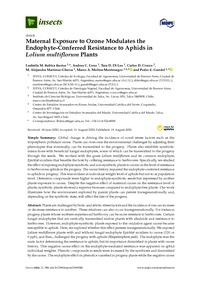Mostrar el registro sencillo de la publicación
Maternal exposure to ozone modulates the Endophyte-conferred resistance to Aphids in lolium multiflorum plants
| dc.contributor.author | Bubica, Ludmila M. | |
| dc.contributor.author | Ueno, Andrea C. | |
| dc.contributor.author | Di Leo, Tara D. | |
| dc.contributor.author | Crocco, Carlos D. | |
| dc.contributor.author | Martínez-Ghersa, M. Alejandra | |
| dc.contributor.author | Molina-Montenegro, Marco A. | |
| dc.contributor.author | Gundel, Pedro E. | |
| dc.date.accessioned | 2020-12-11T19:22:44Z | |
| dc.date.available | 2020-12-11T19:22:44Z | |
| dc.date.issued | 2020 | |
| dc.identifier.uri | http://repositorio.ucm.cl/handle/ucm/3353 | |
| dc.description.abstract | Plants are challenged by biotic and abiotic stress factors and the incidence of one can increase or decrease resistance to another. These relations can also occur transgenerationally. For instance, progeny plants whose mothers experienced herbivory can be more resistant to herbivores. Certain fungal endophytes that are vertically transmitted endow plants with alkaloids and resistance to herbivores. However, endophyte-symbiotic plants exposed to the oxidative agent ozone became susceptible to aphids. Here, we explored whether this effect persists transgenerationally. We exposed Lolium multiflorum plants with and without fungal endophyte Epichloë occultans to ozone (120 or 0 ppb), and then, challenged the progeny with aphids (Rhopalosiphum padi). The endophyte was the main factor determining the resistance to aphids, but its importance diminished in plants with ozone history. This negative ozone effect on the endophyte-mediated resistance was apparent on aphid individual weights. Phenolic compounds in seeds were increased by the symbiosis and diminished by the ozone. The endophyte effect on phenolics vanished in progeny plants while the negative ozone effect persisted. Independently of ozone, the symbiosis increased the plant biomass (≈24%). Although ozone can diminish the importance of endophyte symbiosis for plant resistance to herbivores, it would be compensated by host growth stimulation. | es_CL |
| dc.language.iso | en | es_CL |
| dc.rights | Atribución-NoComercial-SinDerivadas 3.0 Chile | * |
| dc.rights.uri | http://creativecommons.org/licenses/by-nc-nd/3.0/cl/ | * |
| dc.source | Insects, 11(9), 548 | es_CL |
| dc.subject | Transgenerational effects | es_CL |
| dc.subject | Maternal effects | es_CL |
| dc.subject | Fungal endophyte | es_CL |
| dc.subject | Symbiosis | es_CL |
| dc.subject | Rhopalosiphum padi | es_CL |
| dc.subject | Lolium multiflorum | es_CL |
| dc.title | Maternal exposure to ozone modulates the Endophyte-conferred resistance to Aphids in lolium multiflorum plants | es_CL |
| dc.type | Article | es_CL |
| dc.ucm.indexacion | Scopus | es_CL |
| dc.ucm.indexacion | Isi | es_CL |
| dc.ucm.doi | doi.org/10.3390/insects11090548 | es_CL |



